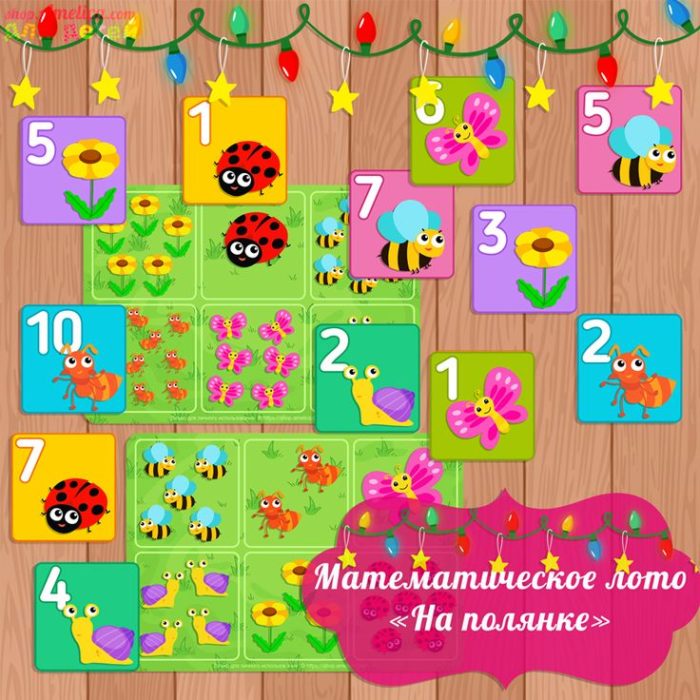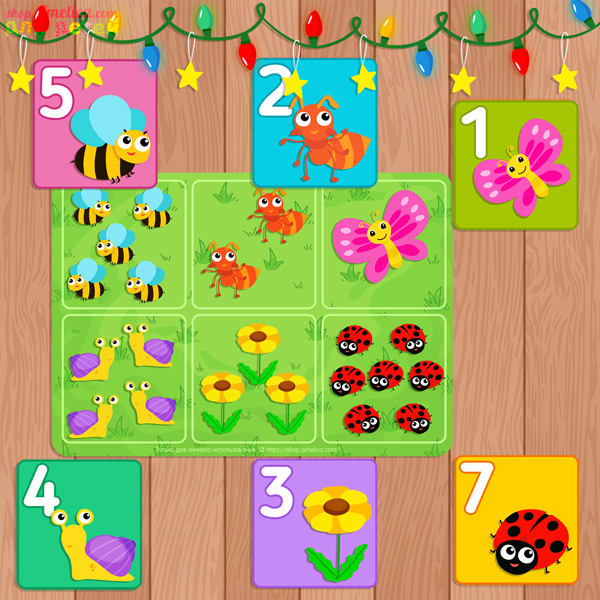Lotto for older preschoolers
In the older group, children are already preparing for school, study numbers, geometric figures, actively explore the world around them. The Lotto game helps them with this..
Geometric Lotto
The didactic game “Geometric Lotto” reinforces ideas about the forms used in geometry, and also about colors.
The teacher distributes cards to the players with several non-repeating images of multi-colored figures. Then he shows small pictures one by one. Children must say, what is the name of the figure, what color is she. Then look, Is there a similar image on their map?. The player takes the card, who found the same figure.
Math Lotto
The Mathematical Lotto game develops counting skills and the ability to compare numbers..


Large cards consist of several cells with different numbers. Animals and things in certain quantities are drawn on small cards. The teacher distributes cards to children, shows pictures. Players count the number of objects on the card, find the corresponding number.
Zoological lotto
In Zoological Lotto, large cards represent images of the nature of continents and seas. This:
- Europe;
- Asia;
- North America;
- South America;
- Africa;
- Australia;
- Antarctica;
- Arctic;
- seas.
Small pictures are images of fauna representatives. The presenter shows the card, names the animal. He takes the card, who finds the corresponding representative of the fauna in his image of the continent. The player wins, the first to collect the animal world on his map.


Lotto for middle group preschoolers
Children 3-5 years are already able to understand the rules of the classical game. Many thematic lotto options have been developed for them..
African palette
The game develops a sense of color in preschoolers, expands understanding of the fauna of Africa. Large cards consist of several images of African animals. Small pictures represent a palette, which consists of several circles, matching the color of a specific animal. The players' task is to find the animal, matching color with the palette.

Professions
The didactic game “Loto” in the middle group expands and consolidates the idea of, where and how do adults work?, fosters respect for other people's work.
Minimum participants participate in the game "Professions" 2 baby, maximum 16. Workers of certain specialties are drawn on 16 large maps, are nearby 3 empty cells. One child takes 1-3 cards depending on the total number of players.
Small pictures show tools, devices, work wardrobe items, related to different professions. The presenter raises the card. The player takes it, which has a specialist drawn on the map, working with the named tool. The one wins, who fills it out first 3 playing field cells.
Moidodyr School
The purpose of the didactic game “Loto” is to consolidate knowledge about the rules of hygiene and culture of behavior. Players receive game cards, which depict a certain everyday situation. Here are the topics covered:
"Learning to wash your hands";

“We set the dinner table correctly”;

"Getting dressed for the street";

"Hygiene and Health";

"Accessories for washing".

The players’ task is to match the large image with pictures like this:, so that a certain sequence of actions is formed
Moreover, placing a card on a cell, the child must explain, what is a drawn object for?, what is the importance of the action depicted?. With the help of the game, preschoolers learn, how to wash your hands correctly, take care of yourself, dress, set the table for dinner
Slide Captions:
Good or bad? Prepared by educational psychologist E.M. Kosterina.
Presentation “Good or Bad” The presentation is based on: 1. Lotto game “GOOD or BAD” for children 4-7 years. MIRROR series”. Development by Zhdanova L.V.. Purpose of the game: familiarizing children of preschool and primary school age with generally accepted norms of behavior, safety and personal hygiene rules. Assessing the behavior of the characters depicted in the game, undoubtedly, children learn norms of behavior. 2. Methodology “Story Pictures” Purpose of the method: study of emotional attitude to moral norms. This presentation can be used as a lesson fragment, to demonstrate “right” and “wrong” behavior and discuss these norms of behavior. Besides, can be used as visual material during the diagnosis of “Knowledge and emotional attitude of children to moral norms and rules of behavior”. Description: The child is presented with pictures depicting positive and negative actions of peers.. Instructions “Choose a picture”, on which a good deed is drawn. Explain your choice". "Choose a picture, where are the children drawn?, who behave well. Explain your choice".
Where children behave well?
Where children behave well?
Where children behave well?
Where children behave well?
Where children behave well?
Where children behave well?
Where children behave well?
Where children behave well?
Where children behave well?
Where children behave well?
On this topic: methodological developments, presentations and notes
Computer: good or bad for your baby?
Computer, like almost any object in our reality can be useful, and harmful Whether we want it or not, but the computer is gradually becoming a common attribute of everyday life - such,like a phone,…
GCD “Winter – Is this good or bad”
Summary of GCD in 2 younger group on the topic “Winter – Is this good or bad” with a problematic situation. Dominant area: “Cognition”. Integration OO: “Communication”, “Socialization”, “Labor”, “Security…
Let's go today, before we start reading Mayakovsky’s poem “What is good and what is bad”, Let's remember a little about our childhood. Let's remember just a little bit, literally half a minute. Fine? A small piece of happy childhood memories has never harmed anyone, Truth?
Here you go. I don't know about you, and I, when I was little, I loved the book with Mayakovsky’s poem “What is good and what is bad”. Is it true, loved the book. I mean, not the text of the poem, and pictures, who illustrated this very text.
And here is the text of the poem “What that's good, what is it? bad" is not me, that did not inspire - rather even amused. I imagined this boy (for some reason years 3-4, Maybe). And my thoughts about his mental abilities were far from enthusiastic. After all, even the most daring flight of fancy did not help me imagine such a child, which is HIMSELF, of my OWN GOOD WILL I came to my father with the question “how to behave correctly?»!
We usually bother with such questions, adults, but certainly not little kids. It's not themselves, and we, adults, We force children to look at the world evaluatively, a comparing glance. We force you to divide actions into good and bad. Divide others into “us” and “strangers”. Making them stop being children.
But the pictures in the book were lovely.. Especially me, for some reason I liked those, where the boy was grimy. Maybe, against his background I felt ideal.
And the gray rectangle is about the boy, which “they don’t even want to put in the book” forced the imagination to work to its fullest: and what does this scoundrel look like??
All in all, Based on my childhood memories, I present to you today the text with pictures of Mayakovsky’s poem “What is good and what is bad”. With pictures from the same, "my" book.
These illustrations were made by a wonderful artist A. Pakhomov. And I'm sure, that you will really like them too. Well, ready? Started!
IN. Mayakovsky

































